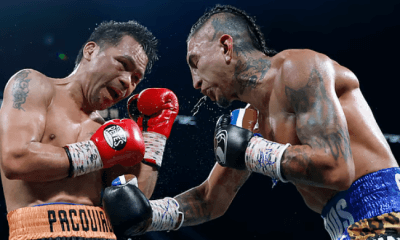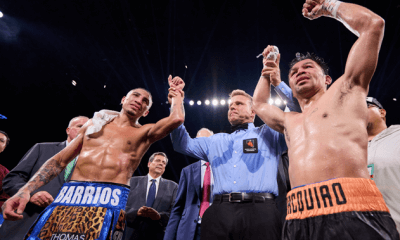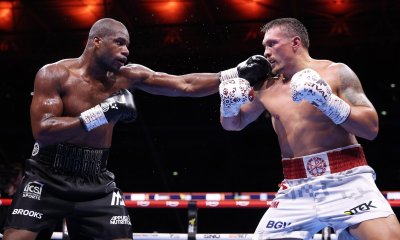Articles of 2007
The Harder They Fall
Somebody much, much smarter than me once wrote that the best boxing films are not, at their core, films about the sweet science: “Raging Bull” is the about one man’s self-destructive tendency towards violence; “Rocky,” “the story of a million-to-one underdog,” is a treatise of human failure’s need for fantasies of fairytale endings; “Million Dollar Baby” is a symbolic tale of the human desire to connect with someone.
Boxing films tend, for the sake of authenticity, to populate their casts with former champions and contenders. Former fighters in the cast for the 2001 film “Ali” include WBO heavyweight titleholder Michael Bentt (as Sonny Liston), former IBF cruiserweight titleholder Al Cole (as Ernie Terrell) and multi-weight champion James Toney (as Joe Frazier). Speaking of Smokin’ Joe, he’s the only professional boxer apart from Burt Young (unbelievable, but true) to appear in the first “Rocky” film. And checking the credits for “Raging Bull” reveals that the role of former light-heavyweight contender Billy Fox was played by former WBA light-heavyweight titleholder Eddie Mustafa Muhammad.
Perhaps the best and most underrated film to actually be about boxing is 1956’s “The Harder They Fall.” The plot is thus: Nick Benko (Rod Steiger), an unscrupulous American boxing promoter, faced with the dearth of talent in the United States, has begun scouring overseas for his next meal ticket which he finds in the unwitting and gullible Argentine giant Toro Moreno (Mike Lane). Toro, it is soon revealed, is a hapless fighter: “a powder-puff punch and a glass jaw… that’s a great combination” one ringside spectator dryly observes at a sparring session. But this means nothing to Benko who takes on unemployed boxing writer Eddie Willis (Humphrey Bogart) to act as Moreno’s publicist and (later) manager. Willis fixes fights for the unknowing Moreno and maneuvers his childlike charge into a heavyweight title fight that Benko and Willis can’t fix. Toro takes a horrendous beating and Willis discovers afterwards that the mob-related Benko has fleeced Toro of the majority of the fight’s revenue through exploitative contracts and creative accountancy, leaving the broken giant with just $49 from his American boxing career. As Benko sells Toro’s contract on to an equally unscrupulous manager, Willis recovers his floundering morals and places Toro on the plane to Buenos Aires, having given his own share ($24,000) of the endeavor.
Directed by Mark Robson, “The Harder They Fall” is notable firstly because it comes from the pen of Budd Schulberg who, two years previously, had written “On the Waterfront,” another great film about the underside of boxing. Secondly and poignantly, “The Harder They Fall” is Bogart’s final film before he died of throat cancer less than a year later and it seems a fitting tribute that his performance is so well-crafted and nuanced. Here, the disease is beginning to take hold and his physical appearance, haggard and weakening, adds to the sense of Willis being tainted by what Jimmy Cannon referred to as “the red light district of sports.”
Steiger, who accompanies Schulberg from “On the Waterfront” and was/is America’s most underrated actor, adds flesh to Nick Benko who easily could have been a two-dimensional monster. Steiger never loses sight of the fact that although Benko is a businessman who will go to any lengths to protect his “interests,” he is also a loving family man who dotes on his children. But Benko inside the world of boxing is perfectly and tacitly described by film critic A.K. Rode as “an absolute hyena.” Not only does Benko coldheartedly exploit Toro, but over the course of the film he is complicit in many criminal and amoral acts including sending two of his “boys” to physically injure Toro’s first American opponent who refuses to take the dive and forcing a sick and injured man into ring causing his death before twisting the subsequent newspaper exposure into good publicity for Toro’s tilt at the championship crown. There is a toe-curling irony when the repugnant Benko calls cynically on God in front of the press to save the life of the man he has just condemned to death.
Adding authenticity to “The Harder They Fall” is a roster of big names from the fight game. Perhaps the most prominent in the cast is Jersey Joe Walcott playing assistant trainer George, a man Willis dubs “a broken-down old warhorse.” Walcott is surprisingly good in the role, improving during the running time and he holds his own in his scenes opposite the theatrically trained and more experienced Bogart. Another notable appearance is made by former journeyman Joey Greb playing himself as a punch-drunk and broke ex-fighter reduced to living in his car. The role of Gus Dundee, the former world champion who dies after his bout with Toro is played by former light-heavyweight contender Pat Comiskey.
It’s worth comparing at this point the heavyweight champion from “The Harder They Fall,” – Buddy Brannen, the boxer Max Baer and “Cinderella Man.” Like “Cinderella Man,” the world heavyweight champion in “The Harder They Fall” is a demon of a man who destroys his opponents and then gloats over their prone figures. A natural showman inside and outside of the ring but not a good one on either side of the ropes, Brannen appears to be the distinct blueprint for Ron Howard’s “Max Baer.” It is ironic then that considering the similarities between the character of Toro Moreno and former heavyweight champion Primo Carnera that the role of Buddy Brannen is played by the then-retired Max Baer.
It’s impossible when watching to ignore the similarities between Toro Moreno and Primo Carnera. Both are foreign (Toro is from Argentina, Carnera was Italian), oversized (Toro is nearly seven feet tall, Carnera was six-feet-five-inches), who are guided in a blaze of publicity towards the heavyweight crown with more than a helping hand from their promoters. And, like Toro Moreno, Carnera was also cheated of his fight purses by the unscrupulous and shadowy figures controlling his career.
Carnera didn’t miss the similarities; he sued, citing that the similarities between himself and Toro Moreno led people to presume that his own boxing career had only been successful through the careful planning, manipulation and criminal activities of unseen others. Surprisingly, Carnera lost the lawsuit. Perhaps it was because of the rumors that had followed Carnera during and after his boxing career that swayed the court’s opinion.
Where “The Harder They Fall” does differ from Carnera’s life is in the final few fights before Moreno challenges Brannen for the heavyweight title. Toro’s penultimate bout to the Brannen fight is his ill-fated contest against Gus Dundee, a reflection of Carnera’s fight against Ernie Schaaf in 1933 after which Schaaf died after being knocked out in the thirteenth round and led to Carnera going on to challenge Jack Sharkey for the heavyweight title. But unlike Gus Dundee, Schaaf was not a former champion but a “contender” or “stand-up guy” whose injuries were not sustained in his previous fight but were thought to have been inflicted by a vicious knockout in the final moments of his ten-round decision loss to Max Baer four fights previously.
Moreno’s destruction at the gloved fists of Buddy Brannen is a twisted distortion of Carnera’s fight against Max Baer. Firstly, Carnera was the champion and not the challenger, having legitimately knocked out Jack Sharkey in six rounds to claim the title. For “The Harder They Fall,” the roles are reversed so Moreno is the challenger to Brannen’s crown.
What’s more is that Moreno is knocked cold in the third round against Brannen; Carnera, in comparison, was stopped in the eleventh after rising from eleven knockdowns. Nor was Carnera an undefeated fighter as is suggested by “The Harder They Fall”; at the time of his fight against Max Baer, he had five losses on his record – three by decision, two by disqualification. Neither does Carnera’s record suggest he was in the same league of punching power as “exhibited” by Toro Moreno. Although undoubtedly heavy-handed, Carnera’s record prior to meeting Max Baer was 79-5-0 (62), a knockout ratio of 78%. But Moreno, we are informed by his trainer, had knocked out his first thirty-eight opponents in Argentina before coming to America, a trend that continues on the path to Brannen (although these fights are undoubtedly fixed). There are only two fights that Moreno doesn’t “win” by knockout: his first fight in America in which a crooked second in the opposite corner throws in the towel after his fighter reneges on the “agreement”; and another where the fighter, refusing to take a dive in his hometown, allows his gumshield to be fitted with chicken-wire, therefore ensuring a technical knockout due to cuts.
As for whether Carnera’s fights were fixed in the same manner as Moreno’s, it is a point still debated. To this date, nobody has come forward and talked openly about fixing the Italian’s record although it is widely accepted that there was the presence of a “helping hand” that took Carnera from obscure European freak-show status to the richest prize in sports. My opinion is that Carnera was better than is generally accepted, not a great boxer but able enough to be guided towards the top. Undoubtedly, he was controlled and exploited by darker elements but there are a number of factors which I believe bear out my assessment: firstly, Carnera had five losses on his record prior to fighting for the heavyweight title so each bout he fought was obviously not organized well in advance; secondly, prior to Baer, Carnera had gone to distance seventeen times in seventy-nine fights – if the fights were being fixed, surely it is easier to persuade one fighter to fall down than to persuade three judges and the newspapers to score for the other; and thirdly, videotape footage of Carnera at training camp reveals a surprisingly well-conditioned, well-coordinated and skilled fighter. I would surmise then that Carnera was an able heavyweight fighter whose backers saw the potential to earn money from the sight of a giant fighting and guided him carefully towards a shot at the heavyweight crown. There were undoubtedly a number of “fixed” fights here and there and fighters chosen specifically to lose but this has always occurred in boxing and makes the case of Primo Carnera no different apart from his size, unique for the time.
Where Moreno’s fight with Brannen matches the Carnera-Baer fight is in the horrendous beating that the Argentine takes. He is knocked down three times in the first, once in the second and, finally, for the count in the third. Carnera, as mentioned before, went down eleven times in eleven rounds.
After seeing the damage to Moreno (broken ribs, jaw; two swollen eyes; a busted mouth), Eddie Willis says simply, “He’ll never fight again.”
Carnera, however, did and he spent the next twelve years fighting throughout Europe, the USA and South America. In his later years, he moved into professional wrestling where, as legend (and not much fact) has it, he beat Max Baer in a “rematch.”
Primo Carnera and Toro Moreno belong in the black-and-white eras of Joe Louis and Humphrey Bogart. Today, unfair comparisons are drawn between the Italian and current WBA-titleholder Nicolai Valuev but things are now different in boxing. Although it is still possible to guide any reasonably talented fighter to title contention and exploit them along the way, it would be impossible for a press agent like Willis to “hide” a real giant from the press. Nor is organized crime so influential – there is not enough money in boxing anymore, nor is its profile sufficiently large enough to justify the expense or the risk promoting a talentless fighter even if they are a giant. Besides, it’s the lawyers and the sports agents who control the commerce in the fight game now.
As the film closes, Eddie Willis steps behind his typewriter to prepare a story on Nick Benko and his minions. He begins by calling for a federal body, a national government entity to regulate the sport.
Maybe, fifty years on, some things haven’t changed.
-

 Featured Articles3 weeks ago
Featured Articles3 weeks agoThe Hauser Report: Zayas-Garcia, Pacquiao, Usyk, and the NYSAC
-

 Featured Articles2 weeks ago
Featured Articles2 weeks agoOscar Duarte and Regis Prograis Prevail on an Action-Packed Fight Card in Chicago
-

 Featured Articles1 week ago
Featured Articles1 week agoThe Hauser Report: Cinematic and Literary Notes
-

 Book Review4 days ago
Book Review4 days agoMark Kriegel’s New Book About Mike Tyson is a Must-Read
-

 Featured Articles4 weeks ago
Featured Articles4 weeks agoManny Pacquiao and Mario Barrios Fight to a Draw; Fundora stops Tim Tszyu
-

 Featured Articles4 weeks ago
Featured Articles4 weeks agoArne’s Almanac: Pacquiao-Barrios Redux
-

 Featured Articles3 weeks ago
Featured Articles3 weeks agoRemembering Dwight Muhammad Qawi (1953-2025) and his Triumphant Return to Prison
-

 Featured Articles4 weeks ago
Featured Articles4 weeks agoOleksandr Usyk Continues to Amaze; KOs Daniel Dubois in 5 One-Sided Rounds













